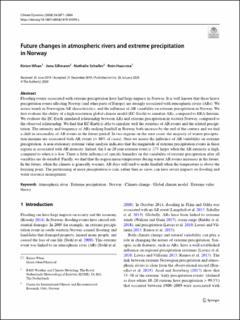| dc.contributor.author | Whan, Kirien | |
| dc.contributor.author | Sillmann, Jana | |
| dc.contributor.author | Schaller, Nathalie | |
| dc.contributor.author | Haarsma, Reindert J. | |
| dc.coverage.spatial | Norway | en_US |
| dc.date.accessioned | 2021-08-25T12:22:08Z | |
| dc.date.available | 2021-08-25T12:22:08Z | |
| dc.date.created | 2020-03-05T12:08:12Z | |
| dc.date.issued | 2020 | |
| dc.identifier.citation | Climate Dynamics. 2020, 54 2071-2084. | en_US |
| dc.identifier.issn | 0930-7575 | |
| dc.identifier.uri | https://hdl.handle.net/11250/2771203 | |
| dc.description.abstract | Flooding events associated with extreme precipitation have had large impacts in Norway. It is well known that these Heavy precipitation events afecting Norway (and other parts of Europe) are strongly associated with atmospheric rivers (ARs). We assess trends in Norwegian AR characteristics, and the infuence of AR variability on extreme precipitation in Norway. We first evaluate the ability of a high-resolution global climate model (EC-Earth) to simulate ARs, compared to ERA-Interim. We evaluate the EC-Earth simulated relationship between ARs and extreme precipitation in western Norway, compared to the observed relationship. We find that EC-Earth is able to simulate well the statistics of AR events and the related precipitation. The intensity and frequency of ARs making landfall in Norway both increase by the end of the century and we find a shift in seasonality of AR events in the future period. In two regions on the west coast, the majority of winter precipitation maxima are associated with AR events (> 80% of cases). Next we assess the infuence of AR variability on Extreme precipitation. A non-stationary extreme value analysis indicates that the magnitude of extreme precipitation events in these regions is associated with AR intensity. Indeed, the 1-in-20 year extreme event is 17% larger when the AR-intensity is high, compared to when it is low. There is little infuence of specifc humidity on the variability of extreme precipitation after all variables are de-trended. Finally, we fnd that the region mean temperature during winter AR events increases in the future. In the future, when the climate is generally warmer, AR days will tend to make landfall when the temperature is above the freezing point. The partitioning of more precipitation as rain, rather than as snow, can have severe impacts on fooding and water resource management. | en_US |
| dc.language.iso | eng | en_US |
| dc.publisher | Springer Nature Ltd | en_US |
| dc.relation.uri | https://link.springer.com/content/pdf/10.1007/s00382-019-05099-z.pdf | |
| dc.rights | Navngivelse 4.0 Internasjonal | * |
| dc.rights.uri | http://creativecommons.org/licenses/by/4.0/deed.no | * |
| dc.title | Future changes in atmospheric rivers and Extreme precipitation in Norway | en_US |
| dc.type | Journal article | en_US |
| dc.type | Peer reviewed | en_US |
| dc.description.version | publishedVersion | en_US |
| dc.source.pagenumber | 2071-2084 | en_US |
| dc.source.volume | 54 | en_US |
| dc.source.journal | Climate Dynamics | en_US |
| dc.identifier.doi | 10.1007/s00382-019-05099-z | |
| dc.identifier.cristin | 1799823 | |
| dc.relation.project | Norges forskningsråd: 255037 | en_US |
| cristin.ispublished | true | |
| cristin.fulltext | original | |
| cristin.qualitycode | 2 | |

